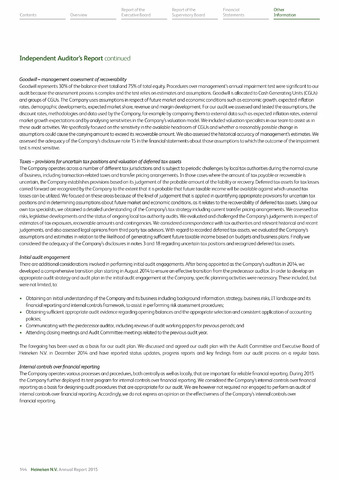Independent Auditor's Report continued
Reportofthe Reportofthe Financial Other
Contents Overview Executive Board Supervisory Board Statements Information
Goodwill - management assessment of recoverability
Goodwill represents 30% of the balance sheet total and 75% of total equity. Procedures over management's annual impairment test were significant to our
audit because the assessment process is complex and the test relies on estimates and assumptions. Goodwill is allocated to Cash Generating Units (CGUs)
and groups of CGUs. The Company uses assumptions in respect of future market and economic conditions such as economic growth, expected inflation
rates, demographic developments, expected market share, revenue and margin development. For our audit we assessed and tested the assumptions, the
discount rates, methodologies and data used by the Company, for example by comparing them to external data such as expected inflation rates, external
market growth expectations and by analysing sensitivities in the Company's valuation model. We included valuation specialists in our team to assist us in
these audit activities. We specifically focused on the sensitivity in the available headroom of CGUs and whether a reasonably possible change in
assumptions could cause the carrying amount to exceed its recoverable amount. We also assessed the historical accuracy of management's estimates. We
assessed the adequacy of the Company's disclosure note 15 in the financial statements about those assumptions to which the outcome of the impairment
testis most sensitive.
Taxes - provisions for uncertain tax positions and valuation of deferred tax assets
The Company operates across a number of different tax jurisdictions and is subject to periodic challenges by local tax authorities during the normal course
of business, including transaction-related taxes and transfer pricing arrangements. In those cases where the amount of tax payable or recoverable is
uncertain, the Company establishes provisions based on its judgement of the probable amount of the liability or recovery. Deferred tax assets for tax losses
carried forward are recognized by the Company to the extent that it is probable that future taxable income will be available against which unused tax
losses can be utilized. We focused on these areas because of the level of judgement that is applied in quantifying appropriate provisions for uncertain tax
positions and in determining assumptions about future market and economic conditions, as it relates to the recoverability of deferred tax assets. Using our
own tax specialists, we obtained a detailed understanding of the Company's tax strategy including current transfer pricing arrangements. We assessed tax
risks, legislative developments and the status of ongoing local tax authority audits. We evaluated and challenged the Company's judgements in respect of
estimates of tax exposures, recoverable amounts and contingencies. We considered correspondence with tax authorities and relevant historical and recent
judgements, and also assessed legal opinions from third party tax advisors. With regard to recorded deferred tax assets, we evaluated the Company's
assumptions and estimates in relation to the likelihood of generating sufficient future taxable income based on budgets and business plans. Finally we
considered the adequacy of the Company's disclosures in notes 3 and 18 regarding uncertain tax positions and recognized deferred tax assets.
Initial audit engagement
There are additional considerations involved in performing initial audit engagements. After being appointed as the Company's auditors in 2014, we
developed a comprehensive transition plan starting in August 2014 to ensure an effective transition from the predecessor auditor. In order to develop an
appropriate audit strategy and audit plan in the initial audit engagement at the Company, specific planning activities were necessary. These included, but
were not limited, to:
Obtaining an initial understanding of the Company and its business including background information, strategy, business risks, IT landscape and its
financial reporting and internal controls framework, to assist in performing risk assessment procedures;
Obtaining sufficient appropriate audit evidence regarding opening balances and the appropriate selection and consistent application of accounting
policies;
Communicating with the predecessor auditor, including reviews of audit working papers for previous periods; and
Attending closing meetings and Audit Committee meetings related to the previous audit year.
The foregoing has been used as a basis for our audit plan. We discussed and agreed our audit plan with the Audit Committee and Executive Board of
Heineken N.V. in December 2014 and have reported status updates, progress reports and key findings from our audit process on a regular basis.
Internal controls over financial reporting
The Company operates various processes and procedures, both centrally as well as locally, that are important for reliable financial reporting. During 2015
the Company further deployed its test program for internal controls over financial reporting. We considered the Company's internal controls over financial
reporting as a basis for designing audit procedures that are appropriate for our audit. We are however not required nor engaged to perform an audit of
internal controls over financial reporting. Accordingly, we do not express an opinion on the effectiveness of the Company's internal controls over
financial reporting.
144 Heineken N.V. Annual Report 2015

